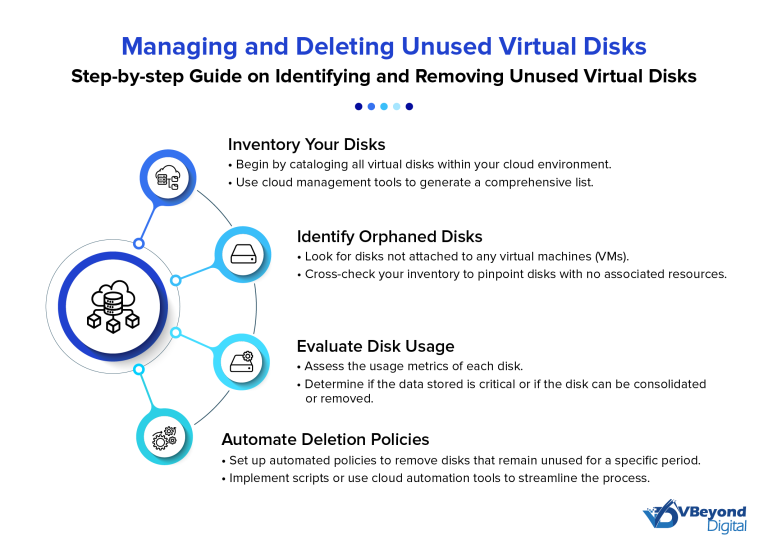Section
Reducing Azure Cloud Expenses for Retail Businesses: Cloud Cost Management
Section
Table of Contents
- Understanding Azure Cost Management in the Retail Sector
- Strategic Cloud Cost Management: What You Need to Know
- Transition to Elastic Database Solutions
- Implementing Storage Tiering
- Description of Different Storage Options
- Guidelines on Selecting the Right Storage Tier
- Capitalizing on Containerization
- Advantages of Containers Over Traditional VMs
- When to Consult Experts to Avoid Potential Increases in Expenses
- Managing and Deleting Unused Virtual Disks
- Step-by-step Guide on Identifying and Removing Unused Virtual Disks
- Right-Sizing Virtual Machines
- How to Determine the Appropriate VM Size and Capacity
- Tools and Practices for Monitoring and Adjusting VM Sizes Based on Demand
- Optimizing Application Dependencies
- Importance of Tracking and Optimizing Performance of Application Dependencies
- Examples of Services and Their Impact on Costs
- VM Start/Stop Scheduling
- Benefits of Creating Custom Start/Stop Schedules for VMs
- Using Tools like Azure Automation Runbooks for Schedule Management
- Automation and Governance on Azure
- How Automation Can Assist in Managing Cloud Operations Efficiently
- Role of Governance in Preventing Overspending and Maintaining Budget Control
- Analyzing with Azure Reporting Tools
- Tools Available for Cost Analysis and Management Within Azure
- Conclusion
Section
This guide focuses on strategic approaches for retail businesses aiming to manage and reduce their expenses on the Azure cloud platform. Through effective cloud cost management, retailers can identify cost-saving opportunities, implement practical solutions, and maintain financial control while ensuring the scalability and reliability of their cloud services. The synopsis outlines various techniques and tools that facilitate efficient spending without compromising on service quality.
A staggering 80% of retail organizations are projected to overshoot their cloud budgets by 2024, as reported by Gartner. In the retail industry, where profit margins are constantly under pressure, effective cloud cost management is not just a fiscal responsibility—it impacts IT performance as well.
Another report by RightScale revealed found and stated in a report that 35% of cloud spend is wasted due to a lack of optimization. Retail CIOs and CTOs thus face the ongoing challenge of effectively deploying the right cloud technologies to drive business growth while also implementing rigorous controls to contain and reduce spiraling costs.
This blog explores effective strategies for retail businesses to manage their Azure cloud expenses, focusing on practical cost-saving measures, efficient resource management, and maximizing return on investment using Azure’s powerful tools.
Understanding Azure Cost Management in the Retail Sector
Azure provides a robust, optimized platform for retail businesses, offering solutions that support e-commerce, data analytics, and customer relationship management and scale as business size and scale. However, without a clear understanding of cost drivers and efficient management strategies, Azure or any other cloud platform can also lead to significant, and sometimes unnecessary, expenses.
For retail enterprises, the primary cost drivers typically include data storage, computing resources, and network bandwidth usage, each influenced by seasonal business fluctuations and promotional activities. Managing these costs effectively not only reduces expenses but also enhances the agility of retail operations.
Strategic Cloud Cost Management: What You Need to Know
Strategic cloud cost management in Azure is essential for retail businesses aiming to maintain profitability and competitiveness in a digital marketplace. It requires a methodical approach to identify, analyze, and optimize cloud resources. Retailers can make informed decisions that lead to cost efficiency and enhanced cloud resource utilization.
Transition to Elastic Database Solutions
Elastic databases offer a flexible and cost-effective alternative to traditional fixed-capacity databases. For retail businesses, transitioning to Platform as a Service (PaaS) solutions like Azure SQL Database Elastic Pools can yield substantial cost benefits.
Traditional vs. Elastic Database Costs
Traditional databases often require extensive provisioning for peak capacity, leading to underutilized resources during off-peak periods. In contrast, elastic databases automatically scale resources based on actual demand, ensuring that retailers pay only for what they use.
Benefits of SQL Elastic Pools for Retail Businesses
SQL Elastic Pools allow multiple databases to share a set of resources at a fixed cost. This is particularly beneficial for retail environments where workload demands can fluctuate significantly. By pooling resources, businesses can handle unexpected spikes in demand without the need for costly over-provisioning.
Implementing Storage Tiering
Storage tiering in Azure provides a strategic way to manage data storage costs without compromising access or functionality. By understanding and selecting the right storage options, retail businesses can optimize their cloud costs significantly.
Description of Different Storage Options
Azure offers several storage tiers, each designed for different usage scenarios:
- Premium: Best for high-performance, low-latency applications.
- Hot: Ideal for data that is accessed frequently.
- Cool: Cost-effective for infrequently accessed data.
- Archive: The most economical option for rarely accessed data.
Each tier has distinct pricing and performance characteristics, allowing businesses to tailor their storage strategy to their specific needs.
Guidelines on Selecting the Right Storage Tier
Choosing the right storage tier involves analyzing data access patterns and business requirements. For instance, transactional data for current customer interactions might be best placed in the Hot tier, while historical sales data that is rarely accessed but must be retained can be moved to the Archive tier.
Strategically moving data between tiers based on usage not only optimizes costs but also ensures that performance requirements are met. Implementing lifecycle management policies can automate the transition of data to more cost-effective storage as its utility decreases over time.
Capitalizing on Containerization
Containerization is a powerful strategy for optimizing cloud infrastructure costs and efficiency. For retail businesses, leveraging containers can significantly reduce the overhead associated with running applications on virtual machines (VMs).
Advantages of Containers Over Traditional VMs
Containers provide a lightweight alternative to VMs, allowing multiple applications to run on a single machine without the need for separate operating systems. This leads to better resource utilization and reduced costs. Containers are ideal for microservices architecture, commonly used in retail applications for their flexibility and scalability.
When to Consult Experts to Avoid Potential Increases in Expenses
While containerization can offer cost savings, it also requires careful planning and expertise to implement effectively. Misconfigured containers or inappropriate use cases can lead to increased costs. Consulting with Azure experts can help ensure that your container strategy is aligned with your business needs and cloud cost management objectives.
For instance, a retail company that switched to Azure Kubernetes Service (AKS) for managing its containerized applications reported a 30% decrease in operational costs due to more efficient resource utilization and automated scaling features.

Managing and Deleting Unused Virtual Disks
Efficient management of virtual disks is crucial for Azure cost reduction. Unused or orphaned disks can accumulate unnoticed, leading to unnecessary storage expenses.
Step-by-step Guide on Identifying and Removing Unused Virtual Disks
- Inventory Your Disks: Utilize Azure’s built-in tools like Azure Cost Management and Azure Policy to generate an inventory of all disks associated with your subscriptions.
- Identify Orphaned Disks: Look for disks not attached to any running virtual machines. These are often left behind after VMs are decommissioned.
- Evaluate Disk Usage: Before deleting, check the last access times and data importance to ensure no critical data is lost.
- Automate Deletion Policies: Implement policies in Azure that automatically delete disks that have been detached for a specified period, ensuring you don’t pay for storage you’re not using.
Right-Sizing Virtual Machines
Right-sizing virtual machines (VMs) is one of the most effective ways to optimize cloud expenses. It involves adjusting the size and power of VMs to match actual usage, ensuring you don’t overpay for unneeded capacity.
How to Determine the Appropriate VM Size and Capacity
- Monitor Usage: Use Azure Monitor to track the performance metrics of your VMs, such as CPU usage, memory, and disk I/O operations.
- Analyze Patterns: Identify underutilized resources by analyzing usage patterns over time. Look for VMs that consistently operate under their capacity limits.
- Adjust Accordingly: Downsize VMs that are consistently underutilized, or consider upsizing those that consistently hit their capacity limits to avoid performance bottlenecks.
Tools and Practices for Monitoring and Adjusting VM Sizes Based on Demand
- Azure Advisor: This tool provides personalized recommendations for right-sizing VMs based on historical usage data.
- Azure Automation: Automate the resizing process using Azure Automation to adjust VM sizes based on predefined rules and schedules, enhancing both cost efficiency and performance.
Optimizing Application Dependencies
Optimizing the performance and cost of application dependencies is crucial for retail businesses leveraging Azure. By fine-tuning the services that applications rely on, such as databases, caching solutions, and messaging services, businesses can achieve significant cloud cost reduction.
Importance of Tracking and Optimizing Performance of Application Dependencies
Application dependencies often account for a substantial portion of cloud costs due to their continuous running state and data transfer requirements. Regularly reviewing and optimizing these dependencies ensures that you are not over-provisioning resources or using expensive services unnecessarily.
Examples of Services and Their Impact on Costs
- Azure Cache for Redis: Enhances application performance by providing high-speed access to data. By effectively sizing and utilizing Azure Cache for Redis, businesses can reduce database load and the associated costs.
- Azure Service Bus: Facilitates communication between different application components. By optimizing message throughput and the number of operations, you can significantly reduce costs associated with messaging operations.
VM Start/Stop Scheduling
Implementing custom start/stop schedules for virtual machines (VMs) is an effective strategy to Azure cost reduction, especially for workloads that do not need to operate continuously.
Benefits of Creating Custom Start/Stop Schedules for VMs
By aligning VM operational hours with actual business needs, you can ensure that you are not incurring costs for computing resources during idle times. This is particularly relevant for development, testing environments, or applications with predictable usage patterns.
Using Tools like Azure Automation Runbooks for Schedule Management
- Azure Automation Runbooks: This tool allows you to automate the start and stop of VMs based on schedules you define. For example, you can set VMs to shut down during off-hours and weekends automatically.
- Azure Logic Apps: This is another tool that can be used to create complex workflows for starting and stopping VMs based on triggers such as workload demand or specific periods.
Section
Section
Start Saving on Azure Now!
Automation and Governance on Azure
Automation and governance are key components of innovative cost management strategies in Azure. These practices help ensure that cloud resources are used efficiently and in compliance with organizational policies.
How Automation Can Assist in Managing Cloud Operations Efficiently
Automation in Azure allows businesses to implement consistent, repeatable processes for deploying, managing, and optimizing resources. This reduces the need for manual intervention, minimizes human error, and ensures that best practices are followed consistently.
- Automated Cost Optimization: Scripts and Azure functions can automatically resize resources, apply tags, and delete unneeded resources based on usage patterns.
- Policy Enforcement: Azure Policy can enforce organizational standards and compliance requirements, ensuring that resources do not deviate from corporate governance standards.
Role of Governance in Preventing Overspending and Maintaining Budget Control
Governance frameworks in Azure help organizations control costs and manage resources effectively by applying rules and regulations that govern resource deployment and usage.
- Cost Management and Budgeting Tools: Azure provides tools to set budgets, forecast spending, and monitor compliance with spending thresholds.
- Resource Organization and Access Controls: Structuring resources effectively and controlling access through Azure management groups and role-based access control (RBAC) helps prevent unauthorized or accidental resource provisioning that could lead to increased costs.
Analyzing with Azure Reporting Tools
Effective analysis with Azure reporting tools is pivotal for maintaining control over Azure cost management. Azure offers a suite of tools that empower retail businesses to track, analyze, and optimize their cloud spending.
Tools Available for Cost Analysis and Management Within Azure
- Azure Cost Management + Billing: This tool provides comprehensive data about your Azure spending and usage. It enables you to view and analyze costs across different resources, forecast future spending, and create custom reports.
- Azure Advisor: Delivers personalized recommendations based on your usage and configurations to help optimize costs, enhance performance, and improve security.
Conclusion
Efficient cloud cost reduction and management is crucial for retail businesses looking to get the maximum ROI for their Azure and cloud investments. By understanding and implementing the strategies discussed—from optimizing databases and storage solutions to automating resource management and enforcing governance—retailers can significantly reduce their Azure expenses while improving operational efficiency.




